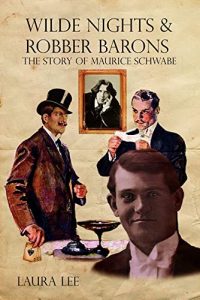Edwardian Con Women by Laura Lee
Edwardian Con Women
Laura Lee
 About ten years ago, while researching a book on Oscar Wilde, I stumbled upon the story of Maurice Schwabe, a member of the Wilde circle who went on to lead an extraordinary life of crime as part of a band of gentleman con artists who traveled the world cheating at cards and collecting secrets to use for blackmail and espionage. The men were clever, dashing, and ruthless and used false titles of nobility to rub elbows with the well-heeled.
About ten years ago, while researching a book on Oscar Wilde, I stumbled upon the story of Maurice Schwabe, a member of the Wilde circle who went on to lead an extraordinary life of crime as part of a band of gentleman con artists who traveled the world cheating at cards and collecting secrets to use for blackmail and espionage. The men were clever, dashing, and ruthless and used false titles of nobility to rub elbows with the well-heeled.
At first glance, it appears to be an entirely masculine story. The leading figures in the gang, according to old articles and police files, were all men. When viewed through the eyes of a 21st century woman, however, a different picture emerges. There were, indeed, women in the room, and they were not the innocent bystanders that the all-male Edwardian police assumed.
There are glimpses of some of the bad characters in corsets throughout the files, though they rarely take center stage. The woman who received the most attention was Florida “Flossie” Settle, and American actress who went by the stage name “Marion Draughn.” Settle was the ideal of beauty of her era, and was a much sought-after artist model, posing for Whistler and others. Settle acted as a decoy, luring men to the tables to be swindled by the men. There are subtle clues that she may have been more central to the criminal organization, and more violent, than the authorities were prepared to believe. One of Settle’s lovers, Carl Franz Gobel, showed up dead in a box. Later Settle was arrested on board a ship returning from one of the gang’s main bases of operations. When she was arrested for firing a gun at a fellow passenger, the press mostly treated it as an amusing society story, and believed her tale that she had shot the man for making fun of her little dog.
Wives and girlfriends of the swindlers were generally seen as their innocent dupes. In 1905, Jeanette Newton dragged her husband Montague Noel Newton into court accusing him of abandoning her, stealing her jewels and failing to support her financially. The press viewed Newton as a heartless cad who took advantage of an innocent lady. Two years later, Jeanette Newton was arrested going by the name Jane Norton. She admitted she had been stealing jewels from her wealthy friends for years.
“I very rarely do business with women,” Montague Newton said. “They are always dangerous.” Yet the record shows he did business with quite a few. The result was often that he went to jail and the women went free. In 1907, Newton’s lover Violet Fraser came up with a plan to make money by forging letters of credit on the legal stationery of the Lewis & Lewis law firm. Fraser came up with the scheme, she stole a piece of letterhead, forged solicitor George Lewis’s signature, and received loans based on false promises in the documents she created. Montague Newton’s role was simply finding a printer to make copies of letterhead. When it came time to stand trial, Fraser claimed to be too ill. Newton went to jail. Fraser did not.
A number of years later, Newton became notorious for his role in a case the press dubbed the Mr. A trial. Another of Newtons lovers, the married Florence Maud Robinson, seduced Sir Hari Singh, the 27-year-old nephew of the Maharajah of Kashmir and set up a situation that allowed Newton to play the role of the husband and catch Singh in the act. (Mrs. Robinson’s husband was in on the conspiracy.) The plan was to extort £300,000. When the plot fell apart, Newton made a deal and became notorious for his testimony in the famous case, Mr. Robinson went to jail, but Florence did not. She spent the next twelve years touring the world.
Bela Klimm, who styled himself Count Adalbert de la Ramee, was a charming swindler who seduced women for fun and profit. The ladies whose fortunes he stole were inevitably painted as innocent victims who knew nothing of the darker side of Klimm’s life. Journalists were especially taken with the story of Klimm’s poor wife Alice Hecht, who was loyal to a fault, visiting her husband in jail, naively disbelieving the charges against him. Yet Hecht knew a great deal. Upon her husband’s arrest she made a deal to secure Klimm’s release by giving the names of his accomplices. A Dutch reporter who spent time with Hecht in Berlin found her“beautiful, rich, coarse and mindless…She takes pride in knowing all about ‘life.’ This ‘life’ is, of course, nightlife with all its depravity and rottenness. She tells whoever will hear that she has tasted all kinds of things, and that nothing human or animal is alien to her… [S]he told me the most agonizing things, and in her madness gave me a glimpse into that fathomlessly deep well called the nightlife of Berlin” Alice seemed to have inside information on the fate of Flossie Settle’s lover, the one who was found stuffed in a box. The journalist reported that Alice had nightmares about Gobel and of detectives coming to capture her.
These are only a few of the women connected to this band of Edwardian criminals. No doubt there were many others who have been rendered invisible to history, by men reluctant to admit they’d been taken by women, and by police who could not believe a lady would commit crime. The small traces they left show that even in the most buttoned-up era, women could be be as devious, immoral and dangerous as men. As we remember the well-born and well behaved, and write biographies of the women who stood up and changed society, it is important, too, to remember the unscrupulous and criminal in order to give the women of the past the full range of humanity.
—
Laura Lee is the author of 21 books including biography, humorous reference, fiction, and children’s literature. The Metro Detroit native brings a unique background to her work. She holds a degree in theater and worked as a professional mime, improvisational comic, and radio announcer before becoming a full time writer. When pandemics and wars do not intervene, she divides her time between writing and producing (and traveling on) ballet master class tours with her partner the artistic director of the Russian Ballet Foundation. Her most recent books are Oscar’s Ghost and Wilde Nights & Robber Barons. She is a regular contributor and on the editorial board of The Wildean.
Follow her on Twitter @LauraLeeAuthor
Blog: https://lauraleeauthor.
WILDE NIGHTS AND ROBBER BARONS
 In 2011, a pair of love letters, hidden for more than a century, were discovered uncatalogued in an archive in Sydney, Australia. They were passionate declarations of love from one young man to another. The writer referred to the recipient as his “darling pretty.” He talked about how much he missed him and imagined sending “millions of kisses all over your beautiful body.” He signed off “your loving boy-wife.” The letters were addressed to Maurice Salis-Schwabe. Of much greater interest was who they came from– Oscar Wilde’s lover Lord Alfred Douglas, known to his intimates as Bosie.
In 2011, a pair of love letters, hidden for more than a century, were discovered uncatalogued in an archive in Sydney, Australia. They were passionate declarations of love from one young man to another. The writer referred to the recipient as his “darling pretty.” He talked about how much he missed him and imagined sending “millions of kisses all over your beautiful body.” He signed off “your loving boy-wife.” The letters were addressed to Maurice Salis-Schwabe. Of much greater interest was who they came from– Oscar Wilde’s lover Lord Alfred Douglas, known to his intimates as Bosie.
Until the discovery, Schwabe had been an obscure figure in the Oscar Wilde story. Although he introduced Wilde to his co-defendant Alfred Taylor, and was, himself, accused of having sexual relations with Wilde, his name was initially concealed, written on a piece of paper instead of being spoken in open court. The testimony made clear, however, that the mysterious “gentleman on the paper” was a catalyst for much of what followed. After Wilde’s first criminal trial ended in a hung jury, the decision of whether or not to re-try him fell on one man, Maurice Schwabe’s uncle, Solicitor General Frank Lockwood, which caused some of Wilde’s supporters to allege a cover up.
But this is just the beginning of Schwabe’s story. In the early 20th Century, Schwabe hosted all-male sex parties for an aristocratic clientele, all the while collecting scandalous secrets that insulated him from prosecution. He spied and cheated on several continents as part of an organized crime syndicate made up of well-dressed, elegant men who adopted false titles of nobility. The false barons made their living traveling around the world on luxury ships, cheating at cards, selling shares in dubious business enterprises, seducing for profit and collecting secrets to be used for blackmail and espionage. They were even suspected of at least one murder. The colorful characters in Schwabe’s orbit were so grand that they seem to have been ripped from the pages of fiction, but it is all true. Hidden for a century in police files, business documents, letters and and articles in many languages in archives on multiple continents, Maurice Schwabe’s story can finally be told.
BUY HERE
Category: Contemporary Women Writers, On Writing
























